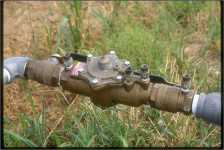Tips to Understanding Drip Irrigation

An irrigation system, like many other production tools, has to be monitored for performance. After all, the goal is to get the highest yields possible, and if your method of applying water isn’t working properly, producing a robust crop becomes more challenging.
For those using a drip irrigation system, Timothy Coolong, associate professor of horticulture at the University of Kentucky, says there are several “ingredients,” in addition to the drip tape itself, that need to work in concert to achieve the desired result. The first order of business, he says, is to make sure all components are regularly checked and cleaned. The parts that make up a system — pumps, back-flow valves, fertilizer injectors, and the filtration system — all contribute to the overall health of the crop.
Pump
For those using surface water from a pond, the first consideration after a water test is the pump. “There are many options for pumps and it is often surprising how much water a small horsepower pump can deliver,”
he explains.
Coolong warns growers to size pumps accordingly. “One acre of drip irrigated crops planted with rows on 6-foot centers would use about 30 gallons of water per minute with standard flow rate drip tapes,” he says. “Be sure to do some rough calculations when determining what size pump to buy.”
A good intake filter is important, too, he adds, as large debris items can do damage to irrigation pumps.
Back-Flow Valve
If the plan is to fertigate using municipal or well water, a high-quality back-flow valve is necessary. “This valve prevents a vacuum from forming and pulling any fertilizer, into the potable water network,” he says.
In this situation, Coolong tells growers to err on the side of caution — and quality. “Inexpensive valves without a vacuum break are generally not accepted by county water authorities,” he explains.
Fertilizer Injector
The next component is the fertilizer injector, which will allow growers to deliver fertility products or chemicals through the irrigation system.
“There are many types of injectors ranging from differential batch tanks to positive displacement pumps, although the most commonly used injectors seem to be those that employ a venturi [injector] to pull fertilizer into the system,” Coolong explains. When injecting fertilizer, he tells growers to use one that is high quality and very soluble.
“Sometimes growers will use a lower grade form of calcium nitrate, which may contain contaminants that can lead to faster clogging of filters or drip tape,” he adds.
Filtration System
The right filter also is important, depending on the type of irrigation water to be used. For those using creek water or pond water, Coolong says a sand filter is a good option as it can remove debris and residue and have a large enough capacity so that growers will not have to flush them as frequently as other filters. He adds, though, that he has worked with growers who have had severe algae problems with their ponds, forcing them to flush large sand filters multiple times per hour.
For growers using clean surface water, he suggests using a disk filter. The drawback to disk filters is they often don’t have the capacity of sand filters and can clog very quickly. In the end, says Coolong, it is best to only use very clean surface water with a disk filter.
Pressure Regulators
The final components Coolong mentions are the pressure regulators for the drip lines. Most drip lines, he says, operate between 8 to 10 pounds per square inch (psi). For growers with very long runs, he says “it would be appropriate to regulate pressure closer to the field so that the system will not lose pressure due to friction loss.”
Water Testing
Testing water quality — whether it is surface water, municipal water, or well water — is recommended in virtually all situations so growers know exactly what they are dealing with, explains the University of Kentucky’s Timothy Coolong.
For example, for growers using well water, it is important to conduct water quality tests because there can be problems with high iron and other minerals clogging the drip tape. To help solve the problem, Coolong notes that some growers put acid injectors in the line that cause the iron to stay in solution.
Other growers follow chlorination procedures with their irrigation water, as they are required to do so when following a food safety plan for a third-party auditor, he adds.
Avoiding Pitfalls
Where growers make errors when putting together a drip irrigation system is with their filter choice, says Timothy Coolong, associate professor of horticulture at the University of Kentucky. As most filters have a maximum gallon per minute rate, growers often base their filter choice on the maximum rating.
“What they don’t realize is that the size or capacity is based on a filter that is perfectly clean, brand new, and running at maximum efficiency,” Coolong warns. More often than not, when the filter starts getting clogged with debris, that will cut down on its flow rate.
“I would encourage growers when sizing their filters to anticipate 50% to 60% of the flow rate that is listed on that filter,” he continues. “This is what the filter will deliver when it starts to accumulate debris. I have seen many growers have to constantly clean out filters because they undersized them.”









